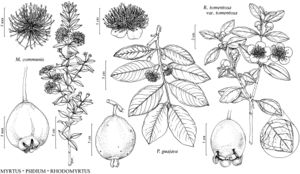Rhodomyrtus
Deut. Bot. Herb.-Buch, 177. 1841.
| Taxon | Illustrator ⠉ | |
|---|---|---|
 | Myrtus communis Psidium guajava Rhodomyrtus tomentosa var. tomentosa |
Shrubs or trees, pubescent, hairs simple. Leaves opposite; blade venation brochidodromous to acrodromous. Inflorescences 1-flowered or 3 [–7] -flowered, axillary, solitary flowers or dichasia. Flowers 4-merous or 5 (–7) -merous, pedicellate; hypanthium campanulate; calyx lobes persistent, distinct; petals pink or red [whitish]; stamens ca. 150; ovary [1–] 3 [or 4] -locular (false septae causing ovary to appear to have 2 times number of locules in fruit); placenta axile or parietal; ovules 16–20 per locule. Fruits berries, purplish black, subglobose, ellipsoidal, or elongate-cylindrical. Seeds usually 20+, reniform, in compact, stacklike rows, each seed surrounded by false, longitudinal and horizontal septae; seed-coat hardened but porous; embryo -shaped; cotyledons linear, shorter than hypocotyl.
Distribution
Introduced; Florida, s, se Asia (Borneo), se Asia (Celebes Islands), se Asia (India), se Asia (Java), se Asia (Lesser Sunda Islands), se Asia (Malaya), se Asia (Moluccas), se Asia (New Guinea), se Asia (Sri Lanka), se Asia (Sumatra), Pacific Islands (New Caledonia), Pacific Islands (Philippines), e Australia
Discussion
Species ca. 11 (1 in the flora).
Selected References
None.